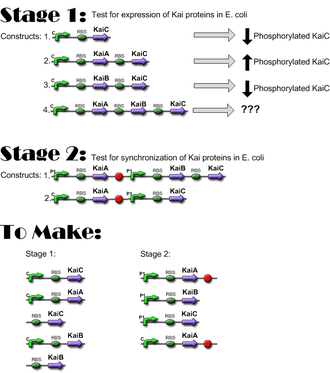IGEM:Harvard/2006/Cyanobacteria
From OpenWetWare
<html><style type='text/css'> .tabs {
font-size:80%;
font-weight:none;
width: 100%;
color: #FFFFFF;
background:#FFFFFF url("/images/5/54/DarkgreenTab-bg.gif") repeat-x bottom;
}
.tabs li {
background:url("/images/3/36/DarkgeenTab-left.gif") no-repeat left top;
}
.tabs a,.tabs strong {
background:url("/images/d/d3/DarkgreenTab-right.gif") no-repeat right top;
color:#FFFFFF;
padding: 3px 10px 3px 4px;
}
.tabs strong{
color:#CCFF00;
background-image:url("/images/b/b1/DarkgreenTab-right_on.gif");
}
.tabs a:hover{
color:#66FF00;
}
</style></html>
Introduction
Welcome to the lab notebook for the Cyanobacteria project! The goal of our team, composed of four members, is to reconstruct the cyanobacterial circadian oscillator system into E. coli. Three proteins, KaiA, B, and C, have been shown to have an in-vitro phosphorylation state oscillation (Nakajima et al. 2005) by transcriptional-translational independent methods. If this system can be reconstituted in E. coli, there are two important applications:
- Synthetic Biology: Creating a functional, oscillating set of proteins is the next logical step from the synthetic "repressilator" system engineered by Elowitz et al. (2000). Although a good proof of concept, the "repressilator" lacks the stability needed from a robust oscillator such as the naturally evolved cyanobacterial oscillator. This robust oscillator could prove useful in an eventual biocircuit.
- Circadian Biology: Cyanobacteria are the simplest model organisms for the study of circadian oscillation. Although circadian oscillation has been fairly well characterized, less is understood at the molecular level. By porting the oscillation system into E. coli, one can begin to understand more precisely the pathways involved in the genomic oscillation of cyanobacteria.
Construct Planning

Lengths
From VF2 to VR (BioBrick primers):
- KaiA + J04500: 1406 bp
- KaiB + J04500: 859 bp
- KaiC + J04500: 2110 bp
Synthesis
Agenda
See image at right for our long-term project outline.

Click here for our current agenda
Kai Gene sizes
- KaiA size: 855bp
- 903bp with BioBrick ends
- KaiB: 309bp
- 357bp with BioBrick ends
- KaiC: 1560bp
- KaiA size: 855bp
BioBricks Used
- <bbpart>BBa_J04450</bbpart>
- RFP device
- Insert size: 1069bp
- [pSB1A2]
- High-copy, AmpR
- Size: 2079bp
- <bbpart>BBa_J04500</bbpart>
- Lac promoter + RBS
- Insert size: 220bp
- [pSB1AK3]
- High-copy, AmpR, KanR
- Insert size: 3189bp
- [pSB4A3]
- Low-copy, AmpR
- Insert size: 3339 bp
- <bbpart>BBa_R0010</bbpart> + <bbpart>BBa_E0241</bbpart>
- GFP device
- Insert size: 995 bp
- <bbpart>BBa_J04450</bbpart>
Presentations
- Project proposal (week 2)
- Week 3 progress update
- Built incubator and obtained WH8102, PCC7942, and PCC6803 strains
- Week 4 progress update
- Week 5 progress update, upd. 10:10 7/17
- Week 6 progress update, upd. 10:02 7/24 HH
- Week 7 progress update
- Week 8 progress update
- Week 9 progress update
- Week 10 progress update, 50% complete
- Final Presentation (incomplete) --old
- Final Presentation (complete) --old
- Jamboree presentation (in progress)
Team Members
- Hetmann Hsieh (talk, edits)
- Jeffrey Lau (talk, edits)
- Zhipeng Sun (talk, edits)
- David Ramos (talk, edits)
Recent Changes
List of abbreviations:
- N
- This edit created a new page (also see list of new pages)
- m
- This is a minor edit
- b
- This edit was performed by a bot
- (±123)
- The page size changed by this number of bytes
26 April 2024
| 11:38 | Hu:Publications diffhist +308 Hugangqing talk contribs | ||||
|
|
N 08:47 | The Paper that Launched Microfluidics - Xi Ning 2 changes history +16,815 [Xning098 (2×)] | |||
|
|
08:47 (cur | prev) −1 Xning098 talk contribs (→Introduction) | ||||
| N |
|
08:43 (cur | prev) +16,816 Xning098 talk contribs (Created page with "{{Template:CHEM-ENG590E}} ==Introduction== Microfluidics is the science and technology of systems that process or manipulate small (10 <sup> -18 </sup> to 10 <sup>−18 </sup> litres) amounts of fluids, using channels with dimensions of tens to hundreds of micrometres, as stated by George Whitesides. <sup> https://doi.org/10.1038/nature05058 1 </sup>. Microfluidic devices are microchemical systems such as labs on the chip, organs on the chip and plants on the chip....") | |||
|
|
08:43 | CHEM-ENG590E:Wiki Textbook 3 changes history 0 [Xning098 (3×)] | |||
|
|
08:43 (cur | prev) 0 Xning098 talk contribs Tag: Manual revert | ||||
|
|
08:42 (cur | prev) 0 Xning098 talk contribs Tag: Manual revert | ||||
|
|
08:41 (cur | prev) 0 Xning098 talk contribs | ||||
|
|
08:20 | (Upload log) [Xning098 (6×)] | |||
|
|
08:20 Xning098 talk contribs uploaded File:XiNingFigure2.jpeg | ||||
|
|
08:14 Xning098 talk contribs uploaded File:Figure4Drawn.XiNing.jpeg | ||||
|
|
08:00 Xning098 talk contribs uploaded File:DrawnFigure4XiNing.jpeg | ||||
|
|
07:38 Xning098 talk contribs uploaded File:XiNingDrawnSetup2.png | ||||
|
|
07:35 Xning098 talk contribs uploaded a new version of File:Figure 2 Set-up1.png | ||||
|
|
07:24 Xning098 talk contribs uploaded File:DrawnElectoosmoticflow.jpeg | ||||
| 05:25 | Ernesto-Perez-Rueda:Contact diffhist −94 Ernesto Perez-Rueda talk contribs | ||||